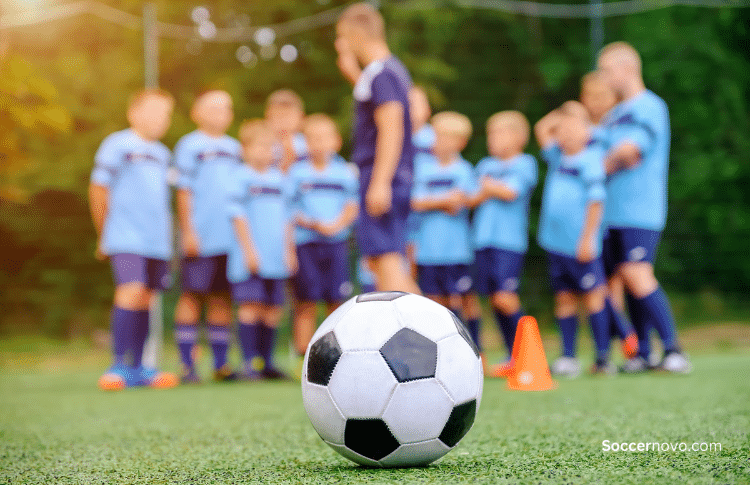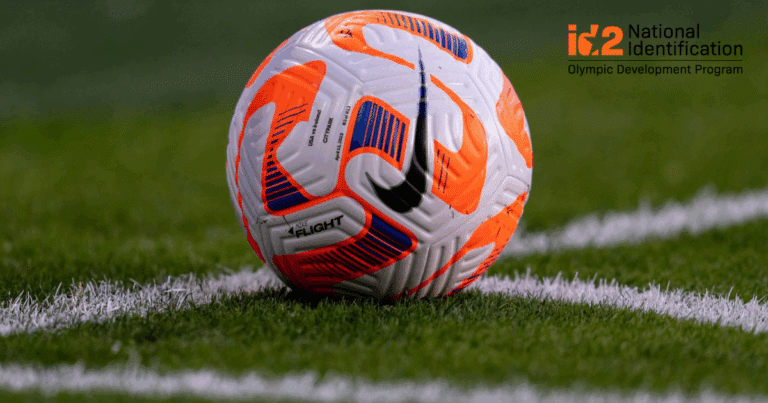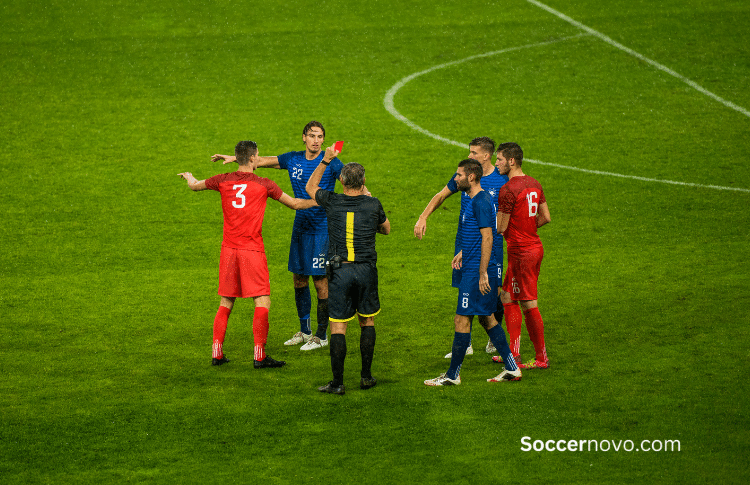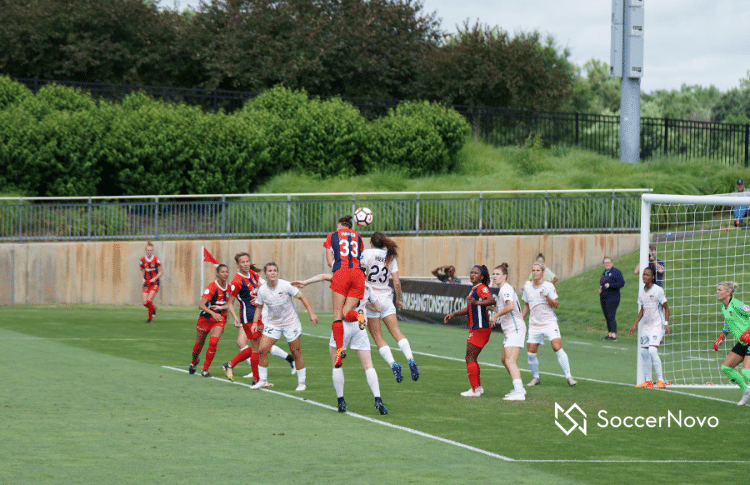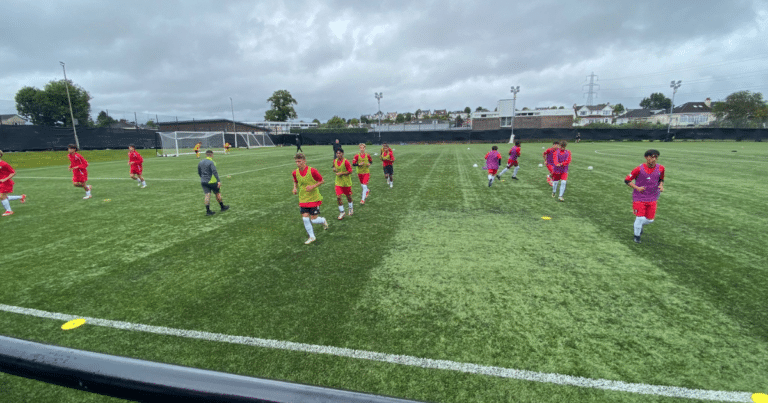7v7 Soccer Rules
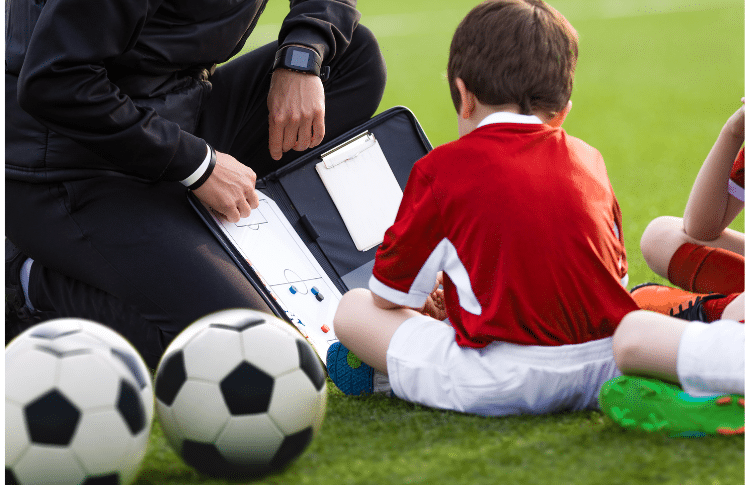
If you’ve stumbled on this page, you might be wondering what the 7v7 soccer rules are? Although most of the rules are the same as a traditional 11v11 match, there are some slight differences.
7v7 soccer is a popular variation of soccer that is often played in younger youth leagues, rec leagues, and even some professional leagues.

In this article, let’s explore some of the basic rules like how many players can be on the field at once (you probably guessed right already), what is needed from each player, the official rules, and the roles of a referee.
The Basics of 7v7 Soccer
If you’re new to 7v7 soccer, it’s important to understand the basic rules and regulations of the game. Here are the key points to keep in mind:
Field Dimensions
The field for 7v7 soccer is typically smaller than a full-sized soccer field. The dimensions of the field can vary, but it is usually around 50-60 yards long and 30-40 yards wide. The goals are also smaller, typically around 6-8 feet wide and 4-6 feet tall.
Number of Players
Each team in 7v7 soccer has seven players on the field at a time, including a goalkeeper. The remaining six players are field players.
Substitutions are allowed at any time during the game, but the player being substituted must leave the field before the replacement can enter.
Soccer Game Duration
A 7-sided youth soccer game typically consists of two 25-minute halves, with a 5-10 minute halftime break.
However, the exact duration of the game can vary depending on the league or tournament rules.
The game clock does not stop for injuries or substitutions, so the actual playing time may be slightly less than the total time allotted for the game.
7v7 Soccer Equipment
This section will cover the necessary player equipment and ball specifications.
Player Equipment
All youth soccer players are required to wear shin guards that are completely covered by their socks. Players without shin guards will not be allowed to participate in the game. It is also recommended that players wear cleats or turf shoes that are appropriate for the playing surface.
Uniforms are also important and must be worn by all players. Each team must have matching jerseys or shirts, shorts, and socks.
The goalkeeper must wear a different color jersey or shirt than their teammates and the opposing team.
In addition, jewelry is not allowed during the game, and players with any type of cast or brace must have it padded and approved by the referee before participating.
Ball Specifications
Typically, the ball used in 7v7 soccer game is a size 4 but I’ve seen size 3 balls used as well.
The smaller ball size is designed to make the game more manageable for younger players and to encourage more ball control and passing.
It is also important to note that the ball must be properly inflated and in good condition before the start of the game.
The referee will check the ball before the game to ensure that it meets the proper specifications. If the ball is found to be underinflated or damaged during the game, it will be replaced with a new ball. This is pretty typical of any age group.
Starting and Restarting the Game
When playing 7v7 soccer, there are several ways to start and restart the game. In this section, we will discuss the different types of kicks and throws that can be used to start and restart the game.
Kick-Off
At the beginning of each half and after a goal is scored, the game is started with a kick-off. The kick-off is taken from the center of the field and all players must be on their own half of the field.
The ball must be kicked forward, and the player taking the kick-off cannot touch the ball again until another player has touched it.
Free Kicks
A free kick is awarded to a team when the opposing team commits a foul. The free kick can be taken from the spot where the foul was committed or from the spot where the ball was when the foul was committed.
The opposing team must be at least 5 yards away from the ball when the free kick is taken.
Throw-Ins
When the ball goes out of bounds on the sideline, a throw-in is awarded to the team that did not touch the ball last.
The player taking the throw-in must have both feet on the ground and must throw the ball with both hands from behind their head.
The opposing team must be at least 5 yards away from the player taking the throw-in.
Goal Kicks
When the ball goes out of bounds over the end line and was last touched by an attacking player, a goal kick is awarded to the defending team.
The ball is placed in the goal area and kicked by a member of the defending team. All attacking players must remain outside the penalty area until the ball is kicked.
Corner Kicks
When the ball goes out of bounds over the end line and was last touched by a defending player, a corner kick is awarded to the attacking team.
The ball is placed in the corner nearest to where the ball went out of bounds and kicked by a member of the attacking team. The opposing team must be at least 5 yards away from the ball when the corner kick is taken.
Rules of Play
When it comes to 7v7 soccer, there are several rules of play that you need to keep in mind. These rules are designed to ensure fair play and a level playing field for all teams.
Offside Rule
In 7v7 soccer, the offside rule is similar to the rule in 11v11 soccer. A player is considered offside if they are closer to the opponent’s goal than the ball and the second-to-last defender, at the moment the ball is played. If a player is offside, the referee will stop play and award a free kick to the opposing team.
With that said, some leagues will not have offside rules instituted. Or, they have on but only for the team’s attacking half.
In any case, it’s important to check your league’s rules before your first game.
Fouls and Misconduct
In any soccer game, safety comes first. Without rules to penalize fouls, soccer could turn into rugby!
There are several types of fouls and misconduct that can result in a free kick or a penalty kick. Some of the most common fouls include:
- Tripping an opponent
- Pushing an opponent
- Holding an opponent
- Jumping at an opponent
- Charging an opponent
If a player commits a foul, the referee may award a free kick or a penalty kick, depending on the severity of the foul.
In addition to fouls, there are also several types of misconduct that can result in a yellow card or a red card. This is very rare and usually, a ref will give several warnings before a card is pulled. Some examples of misconduct include:
- Deliberately handling the ball
- Using offensive language or gestures
- Persistently breaking the rules
- Violent conduct
If a player receives two yellow cards, they will be shown a red card and sent off the field. If a player receives a red card, they will also be sent off the field and their team will have to play with one less player for the remainder of the game.
Scoring and Winning
Goal Scoring
In soccer, scoring is the objective of the game. It’s no different in a 7v7 soccer game.
A goal is scored when the entire ball crosses the goal line, between the goalposts and under the crossbar, without any infringement of the rules. If the ball touches the post or crossbar and bounces back into play, it is not considered a goal.
Each goal scored is worth one point, and the team with the most points at the end of the game wins. If both teams score an equal number of goals, the game ends in a tie (called a draw).
Determining the Winner
In the event of a tie, some leagues or tournaments may have specific rules to determine the winner. One common rule is to have a penalty shootout. Each team selects five players to take penalty kicks, and the team that scores the most goals wins. If the score is still tied after five penalty kicks, the shootout continues with one player from each team taking turns until there is a winner.
It’s important to note that in many youth leagues, a tie may be an acceptable outcome, and no further action is taken to determine a winner. In tournaments, sometimes a winner needs to be determined so the teams will go into overtime or a penalty shootout.
Role of Referees
Youth soccer referees play a crucial role in ensuring that the game is played fairly and safely.
The referee’s primary duty is to protect the players, and they must enforce the rules and explain rule violations to players briefly. They also have the power to change their decision as long as play has not been restarted.
To ensure that games start and end on time, referees must keep game time. They are responsible for starting and stopping the game clock and ensuring that each half is played for the correct amount of time. Referees must also keep track of the score and any penalties or fouls committed by players.
During the game, referees must be vigilant and keep a watchful eye on the players to ensure that they are not engaging in any dangerous or unsportsmanlike behavior. If a player commits a foul or violates a rule, the referee has the power to issue a warning, a yellow card, or a red card, depending on the severity of the infraction.
In addition to enforcing the rules, referees must also ensure that the playing field is safe and suitable for play. They must inspect the field before the game to ensure that there are no hazards or obstacles that could cause injury to the players.
A good referee at this age will keep the game controlled but explain certain things so the players are continuously learning.
Final Thoughts
Typically, U8-U10 plays soccer on a 7v7 field. This is a period when kids are learning about the game of soccer. With a smaller soccer field, each player should get plenty of touches.
If you are a coach reading this, ensure that you are moving players around so they are experiencing different angles and parts of the game. I’ve laid out some of my favorite formations in my eBook ‘Soccer Coaching Made Simple’.
I hope this article has helped! I wish you much success during the season.

Written By: SoccerNovo
SoccerNovo is an independent youth soccer media brand built to help parents, players, and coaches better understand the game and the pathways available in U.S. soccer. Our mission is to make youth soccer simpler, clearer, and more accessible for everyone involved in it.
Let’s connect


